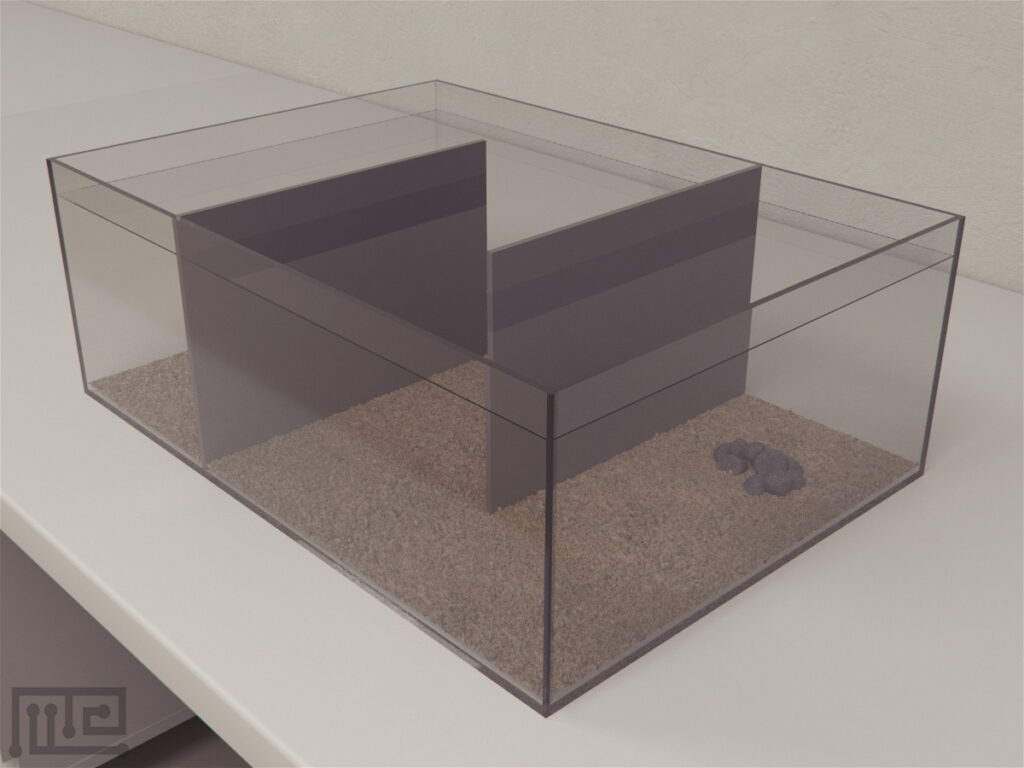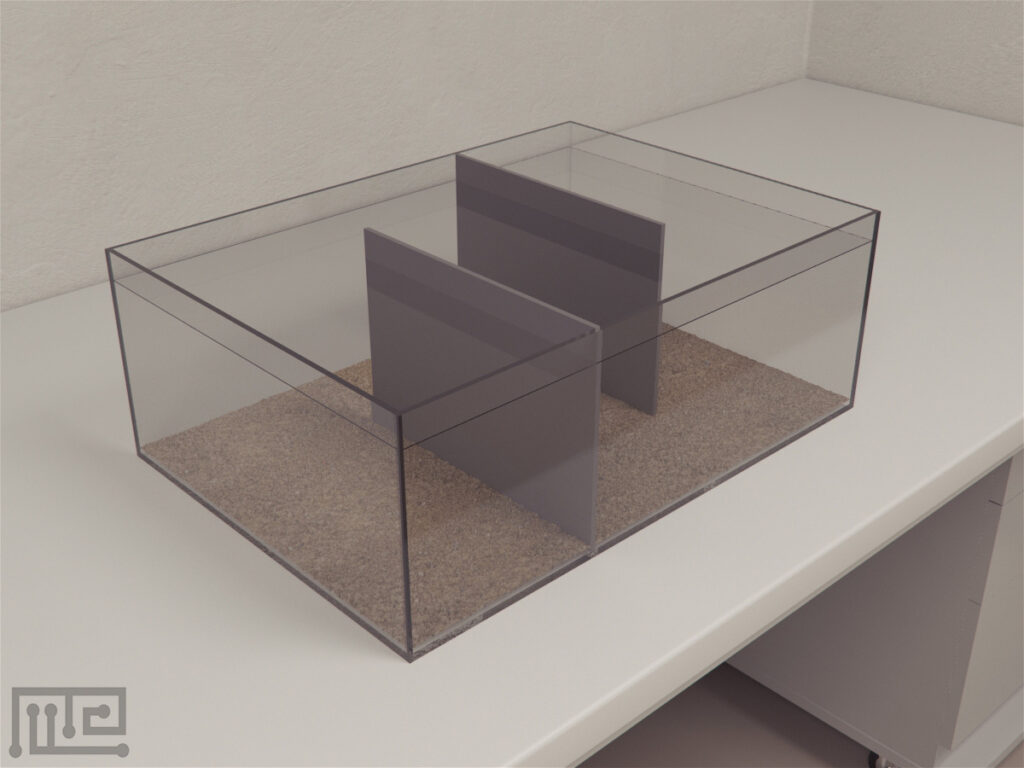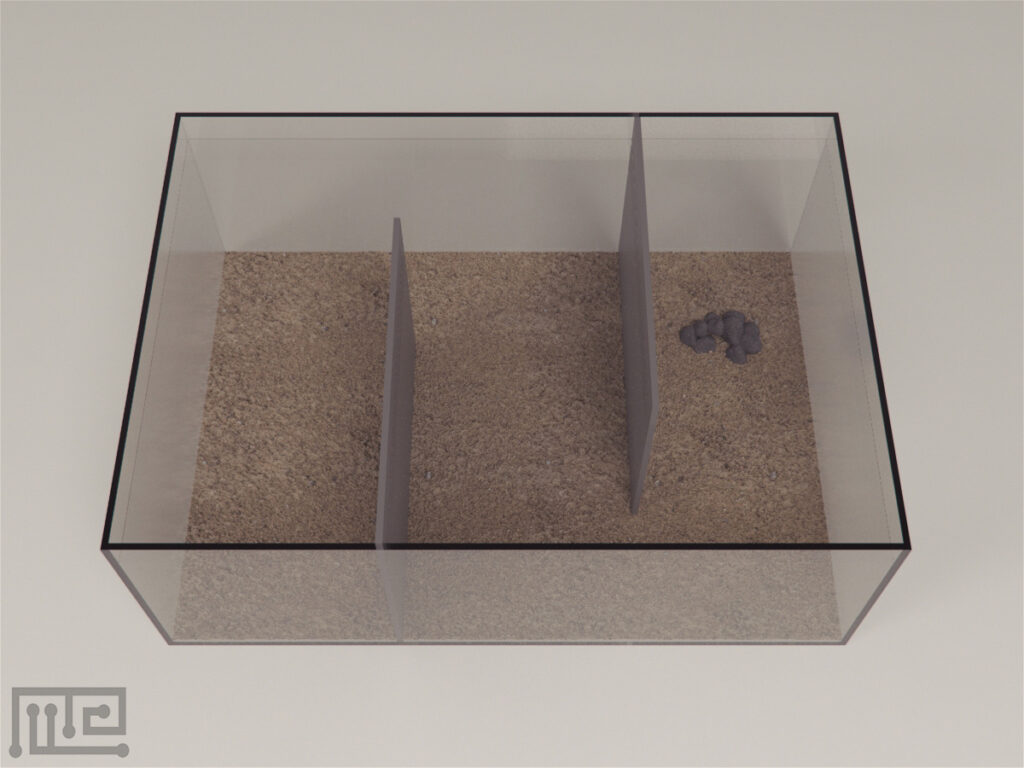The Lobster maze (effect of immediate prior experience) is the second of two arenas used in an experiment by Skylar R. Bayer et al. (2017), to assess the effect of immediate prior experience with shelter on stage V shelter-seeking behavior in lobsters. This was following a previous experiment testing for the effect of post-larval conditioning with shelter on juvenile shelter-seeking behavior in an arena.
It is a simple flow-through maze within a tank with a sand-covered floor, a release point and a rock shelter at one end of the tank.
Mazeengineers offer the Lobster maze.
Price & Dimensions
Lobster Maze
$ 2490
+S&HDocumentation
Introduction
The Lobster Maze (Effect of Immediate Prior Experience) is used to study spatial navigation, memory, and shelter-seeking behaviors in lobsters. It is the second of two mazes developed by Bayer, Bianchi, Atema, and Jacobs (2017) that was used to observe the effect of immediate prior experience with shelter on shelter-seeking behaviors in lobsters. The first maze, which is the Lobster Maze (Postlarval Conditioning with Shelter), is an open arena, which allows the shelter to be visible from all areas of the arena easily. In contrast, in the Lobster Maze (Effect of Immediate Prior Experience), the subjects have to navigate around two opaque partitions to reach the shelter, which challenges their spatial navigation abilities and exploratory behaviors to a greater extent.
Sheltering in lobsters has been shown to be affected by various factors such as predation risk, the size, and shape of the shelter, as well as the presence of different odor cues from conspecifics (Briones-Fourzán, Ramírez-Zaldívar, & Lozano-Alvarez, 2008; Gristina, Fiorentino, Garofalo, 2009). Shelter preferences also vary across different types of lobster species. The Lobster Maze (Effect of Immediate Prior Experience) can effectively be used to observe shelter-seeking behaviors in different lobster species. It consists of a flow-through tank with a sand-covered floor and has a single rock pile shelter placed at one end. Preferences behaviors to different types of shelters can effectively be observed using the Lobster Maze (Effect of Immediate Prior Experience) by utilizing shelters of different shapes, sizes, or materials. Apart from assessing preference behaviors, the Lobster Maze (Effect of Immediate Prior Experience) can also be used to observe the effect of vision on shelter-seeking behaviors since vision plays a major role in spatial navigation. Moreover, it can also be used to observe the effect of water quality, environmental pollutants, and diseases and disorders on spatial navigation, memory, and shelter-seeking behaviors.
Other apparatuses used in assessing different behaviors in other aquatic animals include the Crayfish Light-Dark Maze, the Zebrafish Plus Maze, the Zebrafish Shuttle Box, the Latent Learning Apparatus, and the Mirror Biting Cattelan.
Apparatus and Equipment
The Lobster Maze (Effect of Immediate Prior Experience) is a flow-through maze within a tank that measures 54 x 38 cm. The tank floor is covered with sand, and a rock shelter is present at one end of the tank. Around 5-10 body lengths away from the shelter, a line of sight is marked, which is where the subjects can come into visual contact with the shelter. Two opaque partitions are present in the maze from which the subject has to navigate around to reach the shelter.
Training Protocol
Flush the maze with flow-through seawater for 5 minutes between trials. Appropriately light the apparatus. A tracking and recording system such as the Noldus Ethovision XT can be used to assist with observations.
The following is a sample protocol used to compare the effect of immediate prior experience with shelter on shelter-seeking behaviors using the Lobster Maze (Post-Larval Conditioning with Shelter) and the Lobster Maze (Effect of Immediate Prior Experience) on naïve and conditioned first instar (stage V) juvenile lobsters.
Habituation and Pre-training
Place the “naïve” postlarvae group in the Lobster Maze (Post-Larval Conditioning with Shelter) that contains only a 5-cm layer of sand at the bottom. In contrast, place the “conditioned” postlarvae group in the Lobster Maze that contains a 5-cm layer of sand and 7~15 –cm diameter piles of cobbles placed around the perimeter of the arena to serve as shelters. Provide continuous inflow of seawater to the maze. Feed all postlarvae twice a day. Remove all postlarvae from both mazes when they molt into stage V juveniles. Place the stage V juveniles in mesh holding pens in a flow-through sea table.
The Lobster Maze (Effect of Immediate Prior Experience) Task.
Allow an experimenter blind to either treatment group (naïve or conditioned) to handle and observe the subjects. Place a single rock pile shelter in the Lobster Maze (Effect of Immediate Prior Experience). Transfer a stage V juvenile (naïve or conditioned) from its holding pen into a mesh cage in the maze using a wide-mouth turkey baster. Allow the subject to acclimate for 2 minutes and then release it into the maze at the release point. Allow the subject to explore the arena and find the shelter and enter it. Once the subject is in the shelter and remains there for 2 minutes, remove the cobbles one at a time until the subject is visible. Remove the subject from the maze using gentle suction from a wide-mouth turkey baster and place it back into its mesh holding pen at the release point. Allow the subject to remain in the holding pen for 2 minutes as re-acclimation. Remove the holding pen and conduct another trial.
The Lobster Maze (Post-Larval Conditioning with Shelter) Task
Perform trials in the same manner as the Lobster Maze (Effect of Immediate Prior Experience) Task.
Literature Review
Investigation of the effect of immediate prior experience with shelter in juvenile lobsters
Bayer, Bianchi, Atema, and Jacobs (2017) investigated the effect of immediate prior experience in first juvenile stage (stage V) lobsters using the Lobster Maze (Postlarval Conditioning with Shelter) and the Lobster Maze (Effect of Immediate Prior Experience). The shelter-seeking behaviors of naïve stage V juveniles were compared to conditioned stage V juveniles. The naïve group was placed in the Lobster Maze (Postlarval Conditioning with Shelter) containing only sand in their postlarvae stage. In contrast, the conditioned group was placed in the maze that contained sand and piles of cobbles that served as shelters. During testing in the Lobster Maze (Postlarval Conditioning with Shelter), the subjects were allowed to explore the maze and enter the shelter. After the subject remained in the shelter for 2 minutes, the shelter’s cobbles were removed one by one until the subject was visible, and another trial was conducted. The shelter-seeking behavior of the subject was then compared between the two trials. In the Lobster Maze (Effect of Immediate Prior Experience), trials were performed in the same manner using a separate set of 39 newly molted stage V juveniles. In the Lobster Maze (Postlarval Conditioning with Shelter), the subjects had a clear line of sight to the shelter. In contrast, in the Lobster Maze (Effect of Immediate Prior Experience), the subjects had to navigate around two opaque partitions and cross a line of vision to see the shelter. The results indicated that in the Lobster Maze (Postlarval Conditioning with Shelter), no significant difference in the time taken to initiate sheltering was observed between the two trials in both naïve and conditioned groups. In contrast, in the Lobster Maze (Effect of Immediate Prior Experience), the subjects reached the line of sight more quickly in trial 2 than in trial 1. However, no significant difference between the two trials was observed in time to initiate sheltering between the two trials once the subjects crossed the line of sight
Data Analysis
The following parameters can be observed using the Lobster Maze (Effect of Immediate Prior Experience):
- Time taken for the subject to cross the line of sight
- Time taken to initiate sheltering
- Time spent in the shelter
- Time spent in the rest of the maze
Strengths and Limitations
Strengths
The Lobster Maze (Effect of Immediate Prior Experience) is used to assess shelter-seeking behaviors in lobsters. The two opaque partitions of the maze challenge the subjects’ spatial navigation abilities since the subjects have to navigate around the partitions to see the shelter. The Lobster Maze can also be used to observe preference behaviors to different kinds of shelters in lobsters by utilizing shelters of different shapes, sizes, or materials. Trials can be performed in a short amount of time using the Lobster Maze (Effect of Immediate Prior Experience).
Limitations
Factors such as age, gender, or strain of the subjects may affect task performance. The exploratory drive of the subject is highly important in the completion of the task. Unintentional stimuli may affect task performance.
Summary
- The Lobster Maze (Effect of Immediate Prior Experience) is used to study spatial navigation, memory, and shelter-seeking behaviors in lobsters.
- It consists of a flow-through tank with a sand-covered floor. It also contains two opaque partitions. The release point is present at one end of the maze, and a shelter is placed on the other end.
- The Lobster Maze can be used to observe preference behaviors to different types of shelters based on odor cues or visual stimuli.
References
- Bayer, S. R., Bianchi, K. M., Atema, J., & Jacobs, M. W. (2017). Effects of Prior Experience on Shelter-Seeking Behavior of Juvenile American Lobsters. The Biological Bulletin, 232(2), 101–109. https://doi.org/10.1086/692697
- Briones-Fourzán, P., Ramírez-Zaldívar, E., & Lozano-Alvarez, E. (2008). Influence of conspecific and heterospecific aggregation cues and alarm odors on shelter choice by syntopic spiny lobsters. The Biological bulletin, 215(2), 182–190. https://doi.org/10.2307/25470699
- Gristina, M., Fiorentino, F., Garofalo, G. et al. (2009). Shelter preference in captive juveniles of European spiny lobster Palinurus elephas (Fabricius, 1787). Marine Biology, 156(10), 2097–2105. https://doi.org/10.1007/s00227-009-1240-z




